Kingston Common School: Heatherton School No. 938
In 1867, a well-known member of the local community, Thomas Attenborough, conceived a plan to erect a school at a little known place called Kingston, not far from Cheltenham. This new school was to be called the “Kingston Common School”. To achieve his plan he formed a committee, consisting of himself, H. Way, J. Stooke, J. Aitken and P. Robinson. They went to the Board of Education seeking a grant of £50 to enable them to build a school for the local children. In April 1868 Inspector Sasse from the Board of Education recommended that this grant be approved. [1]
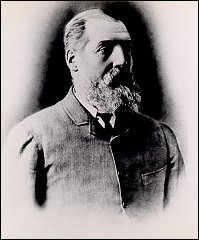
Thomas Attenborough, one of the founder fathers of Heatherton School.
Although the committee had originally wanted to erect a brick structure the grant was only for a timber building. The new school was to be built on land that had been set aside in 1855 in Old Dandenong Road by the Surveyor General, not far from the Wesleyan Methodist Church in what is now Heatherton. In May 1868 the committee was also granted permission to commence teaching in a private cottage pending the opening of the school. [2]
The original school building that was built by the first committee still exists today. Although altered, it is attached to the old public meeting hall at the Heatherton Recreation Reserve Hall in Ross Street, where it is used as a kitchen.
On the 30th, June, 1870 the school was officially opened with Rebecca Waugh (1870-72) as the first head teacher. In the first year she enrolled 25 children from around the Springvale, Clayton, Braeside, Dingley, Clarinda and Kingston (Heatherton) areas. Those children were as follows,
1st Class.
Florence Aitken
Isabella Aitken
Margaret Brownfield
Ellen Cotton
Charles Follett
James Follett
Louisa Follett
Jane Longmuir
James Shields
Thomas Shields
Bessie Stooke
Alice Usher
2nd Class.
Janice Cotton
Eliza Follett
Charles Porter
Mary Porter
Anne Stooke
3rd Class.
James Follett
Thomas Hallinan
Martha Shields
Mary Jane Stooke
Jane Usher
Mary Usher
4th Class.
Anne Beggs
Elizabeth Dyer
The youngest child admitted at this time was Thomas Shields who was only three years and eleven months old and the oldest was Mary Usher who was sixteen years and six months.
Inspector G Wilson Brown when visiting the school in 1871 reported that the building was in good order, “but the out offices require emptying. The furniture and apparatus is still inadequate but is, I understand to be supplemented during the Xmas recess.” [3] He went on to write, “I am disappointed with the work of the school as observed this morning. The classes are not properly grouped at desks, nor is their work sufficiently in accordance with the Board’s programme: employment provided is not continuous, nor always of a very profitable kind, sufficient care is not taken in the correction of slate exercises; the monitorial teaching is very poor; the writing exercises need more supervision and instruction.”
Robert Craig on his inspection some years later, on May 26, 1886, found that the school had an orderly and pleasing appearance, that the discipline was good and suitable teaching methods were being employed. In assessing the various subjects taught he noted that writing was good and above average, spelling a little deficient in 2nd class, good in 3rd and 4th but deficient in the 6th. Tables needed more thorough working in the 1st and 2nd classes but other classes showed satisfactory attainments. Grammar was fair and geography satisfactory. Craig was pleased that the girls in needlework presented useful garments in the 4th, 5th and 6th classes. He also recorded that the Head Teacher taught military drill. The head teacher at the time was P Hotton assisted by his wife and a Miss Hunter. [4]
After the appointment of Rebecca Waugh as the first head teacher, the next three leaders of the school were W. J. Stephens (1873-1874), W. Tuccle (1874-1876) and Peter Hotton (1877-1903). It was W. J. Stephens who was responsible for gaining approval for the building of the head master’s residence on the site adjacent to the school. About the same time that Peter Hotton joined the school as head teacher, his wife was made the local post-mistress and when Mrs Mary Hotton’s suggestion for naming the area ‘Heatherton’ was accepted the name of the school was also changed. [5]
During those early days it wasn’t an easy task being the Head Teacher, male or female, in a country area. They were generally required to live in a house on the school grounds and they taught children of all ages ranging from 4 years to 14 years old in a one-room classroom. If the numbers warranted it the head teacher might have an assistant known as the Sewing Mistress who helped teach such things such as needlework. When the number of pupils increased further a full time assistant could be appointed.
When you talk to many of the older residents who went to school in the area they tell stories of the teachers and students having to cope with poor lighting, shoddy furniture, hard seats and cold conditions in the winter and hot conditions in the summer. They also tell of the lack of adequate sanitation. The younger children used slates and slate pencils. Older children used old type pens with a nib that had to be dunked into the inkwell and if the girl that sat in front of you had long braids you dunked them in the inkwell too, and if you got caught you were punished by receiving the strap or cane. Well, even with all those types of obstacles, teachers still taught and the pupils still learnt, and if you played up you were punished to make sure that they did learn (one way or the other).
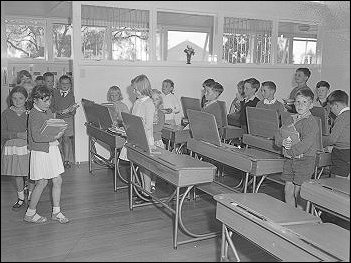
New classroom with dual desks in 1964. From Leader Collection.
An examination of the Pupils’ Registers provides an insight into the changing nature of the home backgrounds of the members of the school community. The occupation of father in the early years of the school was most frequently recorded as ‘market gardener’. Gardener and builder were the next most frequently mentioned occupations but they were significantly less than market gardener. There was the occasional teacher (the head teacher’s children attended the school), poultry dealer, carpenter, gentleman and coach builder but as the years passed a more diverse range of occupations became apparent.
By the beginning of the 1900’s market gardener and gardener were still the most frequently recorded occupations but new occupations were recorded: member of permanent navy, dairyman, plasterer, grocer, grazier, and orchardist. In 1906 a child was enrolled whose father was a solicitor, a rare professional.
By 1953 the range of occupations had increased reflecting wider opportunities in the broader community. Nevertheless there was still a good representation of market gardeners and labourers but they were accompanied by florist, welder, gas and fuel employee, company manager, hospital wardsman, wholesale merchant, traveller, nurseryman, motor mechanic, bricklayer and electrician
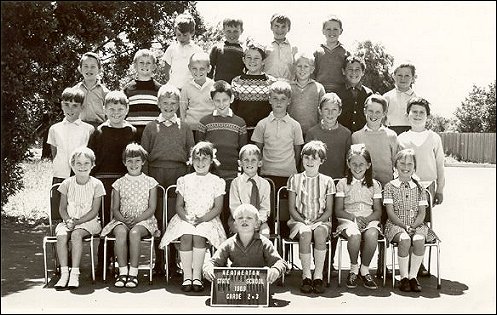
Class Two and Three Heatherton State School 1969. Back Row: Peter White, Jamie Burrows, Darren Rodgers, Hewie Sinclair, Fourth Row: Mark O’Del, Harold Jones, Warren Hancock, David Moron, Clive Parkinson, Ross De Poddi, John Moron; Third Row: Greg Alexander, Robert Swan, Fritz Millace, Steven Amolong, Luke Alexander, John Wilson, Chris Lombarde, Shane Wainwright, Second Row: Wendy Clarke, Susan Gundi, Helen Tilling, Peter Din, Pheonia Lowe, Marcia Smithy, Pheonia McMillan, Front Row: Billy Forbes. Courtesy Pat Rodgers.
Twenty years later there was a new clutch of occupations. No one occupation dominated as was the case in the early history of the school. Examples of occupations recorded 1974-6 were: Managing Director, toolmaker, accountant, hairdresser, milk bar proprietor, Melbourne Metropolitan Board of Works, taxi driver, nurse, industrial engineer, unemployed, pastry cook, fishmonger, butcher, draughtsman, chef, pensioner, weather observer and horse trainer.
Since 1928 the school was strongly supported by the Heatherton State School Mothers’ Club. The Club provided a link between the children, home and school with the aim of helping both teachers and pupils. For example, over a period of four years commencing in 1945, £400 was raised to purchase infant room equipment, an electric urn, library books, gramophone and folk dancing records, projector and films, and piano while also paying for the construction of a basketball court.
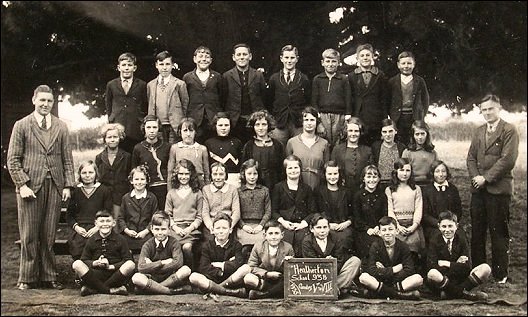
Classes V to VIII at Heatherton State School, 1935. Courtesy Dorothy Allnutt.
For many years the Mothers’ Club paid for the children to be given an Empire Day and Christmas treat as well as working very hard to make the annual picnic a great success. A former student recalled the school picnic at Mordialloc Creek as the best day of the year in 1928. “…it’s a long way to go, so Dad and some other dads bring the horses and drays along and we all pile on and go. It usually takes about an hour. The Mothers’ Club make up raspberry vinegar and sandwiches and we have a jolly good feed, followed by a few races and games while the grown-ups sit about and talk.” [6] When a recorder band was formed among the pupils the Mothers’ Club held an opportunity shop to raise funds towards the purchase of the instruments. [7]
Frances Murray, a member of the Mothers’ Club over eleven years recalled the effort made to raise money for the school. “We had the contract to provide lunches for the golfers at a tournament at the Kingston Heath Golf Club and we had a barn dance in the old hall in Ross Street. It was almost falling down. It was decorated on that occasion with hay and hay bales and we all dressed up. Heatherton was a happy school where parents mixed freely with the staff and developed lasting friendships amongst themselves.” For some time, Frances reported, the school canteen was operating in the staff room sharing the space on one day a week with the teachers.[8]
The school fete was held each year. “We would go around to the factories in Cathy Cody’s beat-up old Holden seeking donations. The market gardeners would donate vegetables and nursery plants. and there was a trash and treasure stall as well as hot dogs from the kitchen. There were also working bees where things were made for the fete. It was like a country fair, everyone came. There was a sign outside the school advertising the fete and one up at the church on the corner. We always hoped it would not rain and most times it didn’t.”
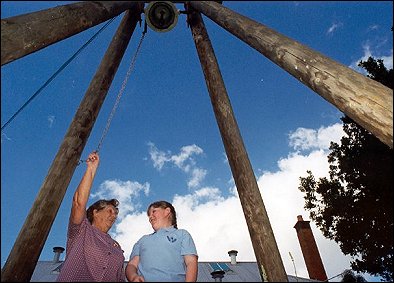
Heatherton Primary School bell with Jean Ryan pupil 1927-1936; Danielle Shaw 1989-1995. From Leader Collection.
On July 26, 1999 the School Council resolved that the school should close and informed the Regional General Manager of this decision. [9] Members of the Council had reached this conclusion after considering finances and projected enrolments. The school had reached an enrolment peak of 175 students in 1993 but since that time the numbers had dropped consistently. [10] Despite efforts of the School Council Promotional Working Party to increase enrolments by distributing information packages, placing signs outside the front of the school, providing before and after school care, visiting kindergartens and implementing a variety of other strategies the target of 15 new enrolments failed to materialise. [11]
With the loss of 22 grade six students and only one enrolment for 2000 in hand, the situation was bleak. Because a school was staffed on the basis of pupil numbers it looked as if there would only be three classes. This situation was not acceptable to many parents who indicated they would remove their children thus aggravating the position. Responding to a School Council survey “Would your children remain at Heatherton if we only had three classrooms next year?” fifty four percent of parents indicated their children would remain at Heatherton but forty five percent voted to leave. Parents’ answers to the question included, “the school will be too small to offer a quality education”, “if it is three classes , my child will be going, also there is not enough students for inter school sports”, “We are shifting house this year and will not be sending our children to Heatherton”, “my child will remain if the majority of children his age do,” “We have no intention of leaving the school”, “If after school care remains available we will continue to send our child to Heatherton but reserve the right to move her if we feel that her level of education is suffering.” [12]
Earlier in the year the possibility of linking with Kingswood Primary School as a single but multi-site school was explored. By April this option was rejected. The School Council News indicated that staffing benefits from this arrangement were ‘problematical’ and although there were some financial gains they were not sufficient to fund some ‘key initiatives’. [13] On December 10, 1999 the General Manager of Southern Region was informed that her recommendation for the closure of Heatherton Primary School had been accepted by the Minister for Education and was directed to take appropriate actions to facilitate the process. Parent assistance grants of $200 per student were provided for those students transferring to another government primary school, and a closure grant of $3000 was made available to meet costs of relocating resources from Heatherton to other government schools. Relocation of resources was to be done after consultation with the School Council and preference was to be given to neighbouring schools enrolling a significant number of pupils from Heatherton. [14]
On November 28, 1999 the school community came once more to Heatherton to recall and celebrate the school’s achievements over one hundred and thirty years. Speeches were made, food devoured, friendships renewed, memories refreshed, and a few tears shed. The contributions of many teachers to the education of the children of the district was acknowledged and best wishes were conveyed to its pupils as they embarked on further learning in new settings.
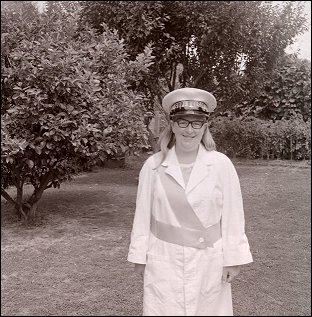
Mrs. Juanita Quinn school crossing supervisor, on Old Dandenong Road, Heatherton.
Footnotes
- Blake, L., (Ed) Vision and Realisation 1973 Volume 3, p314.
- Ibid.
- Inspector’s Register Book, Kingston School No 938.
- Ibid.
- Sheehy, T., A Saga of Heatherton, 1978.
- Ibid.
- Moorabbin News, May 13, 1949.
- Whitehead, G., Interview with Frances Murray 2000.
- Directorate of School Education, Correspondence July 27, 1999.
- Directorate of School Education - School Enrolments, Heatherton Primary School 1983-1999.
- Minutes of School Council Promotional Working Party.
- School Council Minutes.
- School Council News, May 14, 1999.
- Directorate of School Education, Correspondence, December 10, 1999.
